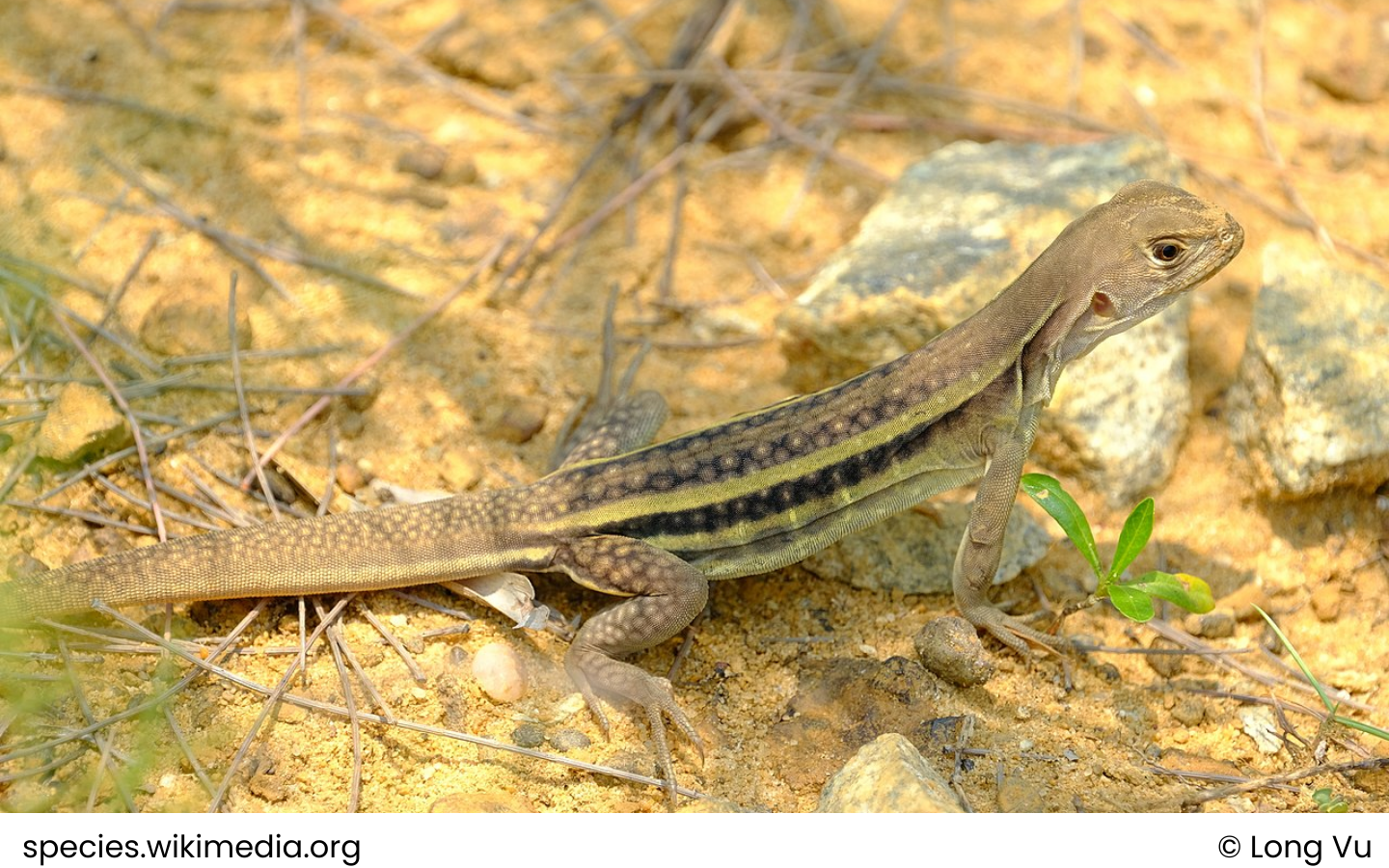
Science name: Leiolepis guentherpetersi – Darevsky & Kupriyanova, 1993
Taxonomic: Animalia>> Chordata>> Reptilia>> Squamata >> Agamidae >> guentherpetersi
Species status: Endemic ; IUCN status: EN (Endangered Species)
Description:
Physical Characteristics:
Leiolepis guentherpetersi is a large, unisexual triploid species (3n = 54).
Snout-vent length: Reaches up to 156 mm.
Rostral: 3-3.5 times wider than it is high.
Ventral scales: 17-20 between the median line of the belly and the small dorsal scales.
Tibial scales: 14-18 enlarged scales across the lower part of the tibia.
Subdigital scales: The fourth toe has 40-43 subdigital scales.
Femoral pores: 21-23 femoral pores.
Dorsal stripe: The species lacks a median dorsal stripe, but transverse stripes formed by rows of 4-5 light oval spots create a characteristic reticulum between the dorsolateral stripes.
Coloration and Appearance:
The body displays distinct light stripes along the sides, with a characteristic reticulate pattern formed by rows of light oval spots.
The coloration and scale patterns are more pronounced and distinctive in comparison to other Leiolepis species.
Distribution and habitat:
Distribution and Habitat:
Elevation: Lowland species, occurring at elevations from 0 to 45 meters above sea level.
Area: This species is endemic to central Vietnam, with isolated subpopulations in Thua Thien–Hue, Da Nang, Quang Nam, and Quang Ngai Provinces. The extent of occurrence is estimated to be around 3,943 km².
Habitat: Leiolepis guentherpetersi inhabits coastal sand dunes that are poorly anchored by sparse bushy and grassy vegetation. It is found in coastal areas, living in sandy soils where it digs burrows. It primarily appears during the rainy season.
Behaviour and ecology:
Lifestyle:
This species is diurnal, active during the day. At night, it retreats into burrows that it digs in the coastal dunes or nearby sandy soils.
It is more commonly seen during the rainy season and becomes scarce during the dry season.
Feeding:
Its diet primarily consists of insects such as grasshoppers, crickets, ants, beetles, and other small invertebrates.
Juveniles and adults have similar diets, with both feeding on a wide variety of insects available in the habitat.
Reproduction:
Leiolepis guentherpetersi is a parthenogenetic species, meaning it reproduces without males. It is a triploid species with three sets of chromosomes.
Females lay eggs between April and July, typically producing 1-3 eggs per clutch.
Conservation and status:
IUCN Red List Category and Criteria:
Endangered (B1ab(iii,v)): Listed as endangered due to its limited extent of occurrence (below 4,000 km²) and ongoing habitat decline caused by harvesting and habitat degradation.
Threats:
Habitat degradation due to coastal development, sand mining, and human disturbances.
Harvesting for food or local trade further threatens the species’ populations.
Conservation Actions:
Protection of coastal dune habitats is essential for the conservation of this species.
More research is needed to monitor population trends and assess the impact of harvesting and habitat destruction.
Crocodile Trail – The Best Birding Trail in Cat Tien National Park
If you’re a birder or nature photographer planning a trip to Vietnam, few places offer [...]
Cong Troi Trail – Top 1 Dalat Plateau Birding Trail Experience
If you’re a birder or nature photographer planning a trip to Vietnam’s Central Highlands, the [...]
How to Identify the Greater Sand Plover, Tibetan Sand Plover and Siberian Sand Plover
Identification Differences within the Sand Plover Complex: The sand plover group, which was traditionally divided [...]
Highlights of Cat Tien National Park Reptiles and Amphibian Endemics
Spanning over 71,350 hectares of tropical forests, grasslands, and wetlands, Cat Tien National Park is [...]
Highlights of Cat Tien National Park Mammals in a World Biosphere Reserve
In addition to reptiles and birds, Cat Tien National Park is also rich in mammals, [...]
Kontum Plateau Endemic and Highlight bird
Kontum Plateau Endemic And Highlight Bird species like Chestnut-eared Laughingthrush and top birding routes while [...]